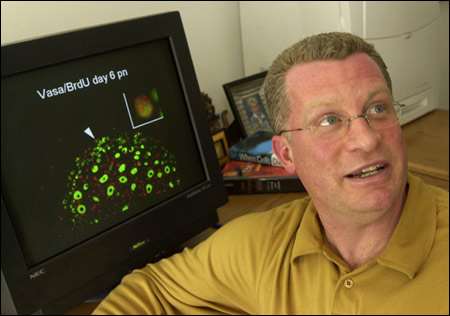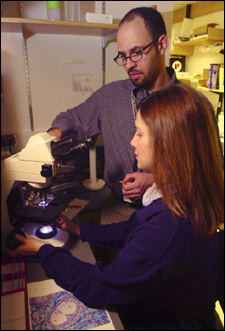Examining cell death, researchers explode belief about life
Harvard scientists show female mammals can generate new eggs

It’s been a year and a half since Jonathan Tilly, Joshua Johnson, and Jacqueline Canning looked at each other and understood that if their experimental numbers were right, a foundation of reproductive biology had to be wrong.
In the intervening months, the excitement hasn’t worn off.
“Our heads are still spinning,” said Tilly, associate professor of obstetrics, gynecology, and reproductive biology at Harvard Medical School (HMS). “Josh and Jackie were in my office going over the results. All three of us had a look of complete shock, amazement, and disbelief all at once. It was a feeling that can’t be conveyed in words.”
Their results indicated that female mammals continue to create egg cells after birth, contrary to long-held scientific belief that females are born with all the eggs they will ever have.
The scientific dogma, taught in biology courses and medical schools around the world, says that female mammals, including humans, slowly use up a fixed pool of eggs and enter menopause when the supply is exhausted.
That foundation underlies not just scientific teaching, but also how researchers for decades have interpreted experimental results and designed treatments, and how physicians have counseled patients.
“Everything we accept and understand about the biology of the ovary, all that now is incorrect,” Tilly said.
The results, published last week in the journal Nature, generated nationwide media attention. The paper’s five authors work at Massachusetts General Hospital’s Vincent Center for Reproductive Biology. Tomoko Kaneko, an HMS research fellow, and James K. Pru, an HMS instructor in obstetrics, gynecology, and reproductive biology, joined Tilly, Johnson, and Canning in authoring the paper. Johnson is an HMS research fellow and Canning is a research technician at the center.
Tilly said he expected the first effects of their findings to be a flurry of publications resulting from researchers going back and re-examining their past work.
“The framework for how we’ve viewed the past 50 years of work has been shaken apart,” Tilly said. “We think the first wave emanating from this will be people going back and reviewing old files and old data that they couldn’t explain, or looking at their findings with fresh eyes.”
Tilly hopes the scientific community accepts their findings, but whether they do or not, Tilly and his colleagues are well on their way to taking the next step:

isolating and culturing the special cells in the ovary, called germ stem cells, that produce the new egg cells.
“We’re moving ahead with this no matter what because we’re completely convinced,” Tilly said.
A numbers game
The researchers became convinced that the traditional picture of ovarian function was wrong after a relatively simple experiment. They counted the number of dead follicles in ovaries of mice (which are thought to have reproductive systems similar to humans). Follicles are tiny sacks within the ovary that hold the egg cells. When the follicle dies, so does the egg.
That initial experiment had a startling result, indicating that up to 1,200 follicles, or close to one-third of the mouse’s entire egg supply, were dying at any given time in each ovary as the females approached adulthood.
“This is where we ran into a huge problem,” Tilly said. “One-third were dying no matter where we looked. And it remained that way well into adult life. It wasn’t hard to imagine that the ovary should cease to function in about two weeks.”
But that couldn’t be. Mice, which reach adulthood at about 7 weeks of age, reproduce until they’re about a year old and retain egg cells in their ovaries until they’re 12 to 14 months old – far longer than two weeks.
In their search to explain their results, the researchers thought that perhaps the ovary functioned as a kind of trash receptacle and that the large numbers of dead follicles they were seeing weren’t dying each day, but accumulating over time.
So they designed two separate experiments to measure how quickly the ovary cleared dead follicle cells. The ovary, it turns out, is pretty efficient, removing dead egg cells within three days.
That left the three of them holding the results of that second experiment in Tilly’s office, looking at each other with amazement.
“We scratched our heads and said, ‘It doesn’t make sense.’ We had the cell death numbers in hand,” Tilly said. “As soon as we did the clearance experiments … that was the ‘Aha!’ moment. The dogma has to be wrong.”
Confirming four ways
The researchers knew that a startling claim such as theirs would have to be bolstered by further experimental evidence. So they designed four more experiments to build their case.
The first was to prove that germ cells – the precursor cells for egg production – were dividing to produce more of themselves in adult ovaries. They did so, by two different approaches.
The second experiment was based on the understanding that mature sex cells, such as eggs and sperm, undergo the process of meiosis when they’re formed.
So, the researchers reasoned, if mammals are creating egg cells all the time, there should be evidence of meiosis in adult mouse ovaries. They examined the ovaries and found a protein called SCP3, which is only produced during meiosis.
Next, they reasoned, if they were correct that there was a continual supply of follicles and eggs being produced, shutting off that supply should result in a greatly decreased stock of egg cells, even if they do nothing to harm the existing stock of eggs.
They used a chemical called busulphan, which is known to kill germ stem cells in the testes of males. Used in females, they thought it would kill germ stem cells that create the egg cells, but would not harm the eggs themselves.
Twenty days after treating the mice with busulphan, they found less than 5 percent of the egg stock remained.
Their final experiment sought to document the formation of new egg-containing follicles. They transplanted normal ovary tissues into mice that had been genetically engineered to contain a protein that glows green. After a short time, they examined the ovaries and found green-glowing egg cells inside the sack-like follicles within the transplanted normal ovary tissue. The eggs must have developed inside the adult mice after the transplantation.
“Take all five [experiments] together and they all tell us the same thing,” Tilly said. “The dogma just can’t be.”
Fertility, chemotherapy
In hindsight, Tilly and Johnson both said it seems somewhat obvious that the original theory was wrong. In several lower animals, such as fruit flies, fish, and chickens, the females continue to manufacture eggs throughout their lives, much as males manufacture sperm cells.
That evolution would suddenly switch to a system in mammals where a large store of eggs is created at birth and then waits for years or even decades before being used – subject to damage the whole time – really wasn’t logical.
“All of a sudden, the ovary made sense,” Johnson said.
Tilly credited his lab’s focus on cell death for the breakthrough. For the past 10 years, he said, their research has focused on cell death as it relates to the egg cell. Their aim has been to figure out how to restore fertility to chemotherapy patients or, by prolonging the lives of follicles and the egg cells they contain, to delay menopause and the associated physical changes it brings.
Past researchers, in contrast, have focused on live cells in the ovary, counting the numbers of living egg cells and watching their number decline over time. Those observations, Tilly said, led to the theory that females are born with a finite egg supply that is used up until it is exhausted. But it was only by looking at follicular death and degeneration that the MGH researchers were able to observe the hidden part of the cycle: the death, removal, and generation of thousands of follicles in the ovary throughout juvenile and adult life.
“We’ve just noticed there’s an iceberg under the surface of the water,” Johnson said. “I am so excited because of all the different directions we can go with it.”
Their research has created a much more dynamic picture. Females are indeed born with a stock of egg cells, but the new research shows that those egg cells die fairly rapidly, and are replenished with new eggs developing in follicles near the ovary’s surface.
The eggs die at a slightly faster rate than they are replenished, creating the observed slow decline in the overall pool of egg cells. Instead of human egg cells lasting as long as five decades as they would have to under the old understanding of ovarian function, Tilly estimated they may have lifetimes as short as three to five years.
Tilly is confident their mouse results will be confirmed in humans and said the promise of therapies that could arise from their research is exciting.
The ovarian germ stem cells that produce the new eggs could themselves be harvested and frozen and transplanted in women later in life, recharging ovarian function in cases of infertility. Once the function of these new germ stem cells is understood, they can perhaps be stimulated with hormone therapy. Rejuvenated ovaries could help delay or ease the physical changes that women go through after menopause.
In addition, the understanding of medicines and toxins in food and the environment that are known to affect female fertility need to be re-examined to see whether they affect the egg cells themselves or whether they are affecting the germ stem cells that give rise to the new eggs.
“It just opens up enormous possibilities that we couldn’t fathom before,” Tilly said.




